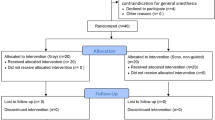Abstract
We report a case each of duodenorenal and colorenal fistula that arose after computed tomography-guided percutaneous cryoablation (PCA) for renal cell carcinoma and use imaging and endoscopic findings to analyze their causes and mechanisms. Both complications occurred though the edge of the iceball did not touch the intestinal wall, and patients’ symptoms and fistula formation occurred several days after the PCA procedure. Based on imaging and endoscopy findings, we suspected the colorenal fistula resulted from bowel injury caused by ischemia from the occlusion of small vessels at the procedure’s low temperature. Both cases were resolved conservatively without surgical intervention.


Similar content being viewed by others
References
Georgiades CS, Rodriguez R. Efficacy and safety of percutaneous cryoablation for stage 1A/B renal cell carcinoma: results of a prospective, single-arm, 5-year study. Cardiovasc Intervent Radiol. 2014;37(6):1494–9.
Blute ML Jr, Okhunov Z, Moreira DM, et al. Image-guided percutaneous renal cryoablation: preoperative risk factors for recurrence and complications. BJU Int. 2013;111(4 Pt B):E181-5.
Atwell TD, Carter RE, Schmit GD, et al. Complications following 573 percutaneous renal radiofrequency and cryoablation procedures. J Vasc Interv Radiol. 2012;23(1):48–54.
Morgan AI, Doble A, Davies RJ. Successful conservative management of a colorenal fistula complicating percutaneous cryoablation of renal tumors: a case report. J Med Case Rep. 2012;26(6):365.
Vanderbink BA, Rastinehad A, Caplin D, Ost MC, Lobko I, Lee BR. Successful conservative management of colorenal fistula after percutaneous cryoablation of renal-cell carcinoma. J Endourol. 2007;21(7):726–9.
Livraghi T, Solbiati L, Meloni MF, Gazelle GS, Halpern EF, Goldberg SN. Treatment of focal liver tumors with percutaneous radio-frequency ablation: complications encountered in multicenter study. Radiology. 2003;226(2):441–51.
Rhim H, Yoon KH, Lee JM, et al. Major complications after radio-frequency thermal ablation of hepatic tumors: spectrum of imaging findings. Radiographics. 2003;23(1):123–34.
Froemming A, Atwell T, Farrell M, Callstrom M, Leibovich B, Charboneau W. Probe retraction during renal tumor cryoablation: a technique to minimize direct ureteral injury. J Vasc Interv Radiol. 2010;21(1):148–51.
Erinjeri JP, Clark TW. Cryoablation: mechanism of action and devices. J Vasc Interv Radiol. 2010;21(8 Suppl):S187–91.
Miller JM, Julien P, Wachsman A, Van Allan RJ, Friedman ML. The role of embolization in reducing the complications of cryoablation in renal cell carcinoma. Clin Radiol. 2014;69(10):1045–9.
Gangi A, Tsoumakidou G, Abdelli O, et al. Percutaneous MR-guided cryoablation of prostate cancer: initial experience. Eur Radiol. 2012;22(8):1829–35.
Lian H, Guo H, Zhang G, et al. Single-center comparison of complications in laparoscopic and percutaneous radiofrequency ablation with ultrasound guidance for renal tumors. Urology. 2012;80(1):119–24.
Schmit GD, Atwel TD, Leibovich BC, et al. Percutaneous cryoablation of anterior renal masses: technique, efficacy, and safety. Am J Roentgnol. 2010;195(6):1418–22.
Campbell C, Lubner MG, Hinshaw JL, Muñoz del Rio A, Brace CL. Contrast media-doped hydrodissection during thermal ablation: optimizing contrast media concentration for improved visibility on CT images. Am J Roentgenol. 2012;199(3):677–82.
Georgiades C, Rodriguez R. Renal tumor ablation. Tech Vasc Interv Radiol. 2013;16(4):230–8.
Conflict of interest
All authors declare that they have no conflicts of interest.
Statement of Informed Consent
Informed consent was obtained from all individual participants included in the study.
Author information
Authors and Affiliations
Corresponding author
Rights and permissions
About this article
Cite this article
Shimizu, K., Mogami, T., Michimoto, K. et al. Digestive Tract Complications of Renal Cryoablation. Cardiovasc Intervent Radiol 39, 122–126 (2016). https://doi.org/10.1007/s00270-015-1110-7
Received:
Accepted:
Published:
Issue Date:
DOI: https://doi.org/10.1007/s00270-015-1110-7




